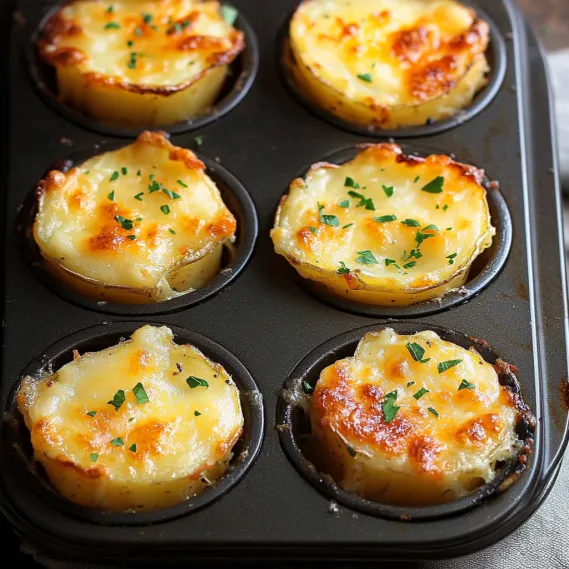 Pin it
Pin it
These irresistible mini potato gratin stacks transform the classic French potato dauphinoise into adorable individual portions that deliver the perfect ratio of creamy interior to crispy, caramelized cheese edges. Each bite offers layers of thinly sliced potatoes infused with garlic-scented cream and melted cheese, creating a luxurious texture contrast between the tender interior and golden crust. Made in a standard muffin tin, these elegant stacks make an impressive presentation whether served as a sophisticated side dish, a delicious addition to brunch, or as upscale finger food for gatherings. They're the perfect example of how something so simple can become extraordinary with just a little extra effort.
The first time I served these at a family gathering, they disappeared faster than any other dish on the table. What I love most is how everyone gets their own perfect portion with those coveted crispy cheese edges. My sister-in-law, who usually passes on potatoes, took seconds and asked for the recipe – that's when I knew these were truly special!
Essential Ingredients and Selection Tips
- Potatoes: Use starchy varieties like Russets, Sebago, or King Edwards that become fluffy when cooked and absorb the cream. Long, cylindrical shapes minimize waste when trimming.
- Gruyere Cheese: Offers the perfect balance of flavor and melting quality. Swiss, cheddar, or Colby make good alternatives, but avoid mozzarella as it lacks sufficient flavor.
- Heavy Cream: The thicker consistency pools beautifully between potato layers. Light cream or half-and-half won't create the same rich result.
- Fresh Thyme: Provides classic aromatic flavor that complements the potatoes perfectly. If using dried, reduce the amount by one-third.
- Butter and Garlic: Form the flavor foundation of the cream sauce, infusing every layer with richness and depth.
I've found through extensive testing that taking the time to select the right potato makes all the difference. When using starchy potatoes, the layers meld together beautifully when baked, while waxy varieties tend to separate when cut into, creating a less cohesive stack.
Detailed Cooking Instructions
- Step 1: Prepare Your Potatoes Perfectly
- Peel potatoes and trim into rough cylinder shapes that match your muffin tin diameter. Slice into thin 2mm (1/10-inch) rounds using a mandolin or sharp knife. Separate slices with your fingers to ensure cream penetrates between all layers.
- Step 2: Create The Flavorful Cream Base
- Melt butter in a saucepan over medium heat, then sauté minced garlic for 20 seconds until fragrant but not browned. Add heavy cream and salt, simmering for 30 seconds to infuse the garlic flavor throughout.
- Step 3: Assemble Your Stacks Strategically
- Brush muffin tin with melted butter, then layer potato slices halfway up each cavity. Drizzle with half the cream mixture, top with a slice of cheese, then add more potato slices until they extend slightly above the rim.
- Step 4: Master The Two-Stage Baking
- Cover loosely with foil and bake at 350°F (180°C) for 40 minutes until potatoes are completely tender when pierced with a knife. Remove foil, top with shredded cheese, and bake uncovered for 10 additional minutes until golden and bubbling.
- Step 5: Finish With Professional Touches
- Sprinkle hot stacks with reserved fresh thyme for color and aroma. Let rest for 5 minutes before carefully removing from the tin using a tablespoon or butter knife to loosen the edges.
 Pin it
Pin it
I learned through trial and error that pre-baking the stacks halfway before adding the top cheese produces a better result than adding all the cheese at once. The first time I made these, I added all the cheese before baking and ended up with overly browned tops but undercooked centers. The covered baking followed by the uncovered cheese finish creates the perfect balance of tender potatoes and golden crust.
The Secret To Perfect Wok Technique
High heat is essential for authentic fried rice. My grandmother taught me to heat the wok until smoking before adding oil. Keep ingredients moving constantly to achieve that elusive "wok hei" flavor. Never overcrowd the pan—cook in batches instead. This technique transformed my fried rice into restaurant-quality perfection.
 Pin it
Pin it
Making The Most Of Leftovers
This dish excels at transforming leftovers into something exciting. I've used roast chicken, holiday ham, and even Thanksgiving turkey with great success. Cut meat into uniform pieces that distribute evenly throughout. Leftover grilled steak adds incredible depth with its smoky edges. Even roasted vegetables bring delightful caramelized sweetness.
Balancing Flavors And Textures
Special fried rice succeeds through balanced components. Char siu provides richness, prawns add sweetness, eggs contribute silkiness, while vegetables offer freshness. The sequence matters—aromatics first build flavor, eggs midway remain distinct, vegetables maintain crispness. Adding spring onions last preserves their brightness for that authentic restaurant finish.
Customization For Dietary Needs
This dish adapts easily to dietary restrictions. For vegetarians, I omit meat, double eggs and add extra vegetables. Low-carb diners enjoy my cauliflower rice version that carries flavors beautifully. For gluten-sensitive guests, tamari replaces soy sauce while ensuring chicken powder is certified gluten-free. Everyone enjoys this beloved dish regardless of restrictions.
Flavor Variations Worth Exploring
While the classic version is perfection, I've created several delicious variations for different occasions. For an herb-lover's version, add finely chopped rosemary and sage to the thyme for complexity. My Italian-inspired adaptation incorporates a thin slice of prosciutto between potato layers and replaces gruyere with fontina and parmesan. During autumn, I sometimes add very thin apple slices between potato layers with a pinch of nutmeg in the cream for a seasonal twist. For a breakfast version, I occasionally mix finely chopped crispy bacon into the layers, which pairs wonderfully with eggs Benedict on the side.
Make-Ahead Strategies For Entertaining
These gratin stacks are entertaining heroes because they can be completely prepared in advance. I often make them the day before a dinner party, refrigerate overnight, and reheat at 350°F for 10 minutes just before serving. They maintain their structure and flavor perfectly, allowing you to focus on other last-minute preparations. For larger gatherings, I make double batches, freezing half after the initial baking. When needed, I thaw them overnight in the refrigerator and finish with the final cheese and bake for a freshly-made taste with minimal effort.
Perfect Pairing Suggestions
The versatility of these potato stacks makes them ideal alongside numerous main courses. They shine particularly beautifully next to a medium-rare ribeye steak, where the crispy potato edges complement the steak's charred exterior. For holiday meals, they make an elegant alternative to standard mashed potatoes alongside roast turkey or ham. At brunch, I serve them with poached eggs and smoked salmon, allowing the runny yolk to create an impromptu sauce that's absolutely divine. For cocktail parties, I make mini versions in petit four tins, serving them room temperature as sophisticated finger food.
 Pin it
Pin it
These Cheesy Mini Potato Gratin Stacks have become my signature dish for special occasions, combining everyday ingredients into something that feels truly special. They prove that sometimes the most impressive dishes aren't about exotic ingredients or complex techniques – they're about presenting familiar flavors in new, thoughtful ways. The combination of crispy edges, creamy centers, and individual portions makes these humble potato stacks feel like restaurant-quality cuisine that anyone can create at home.
Frequently Asked Questions
- → Can I use a different type of potato for this recipe?
- You need to use starchy or all-purpose potatoes (like Russet, Sebago, or Yukon Gold) for this recipe. Waxy potatoes won't break down properly when cooked, which means the layers won't stick together and your stacks may fall apart. The starch helps create that creamy interior texture while maintaining the stack shape.
- → What's the best way to slice the potatoes evenly?
- A mandolin is the ideal tool for getting consistently thin (2mm) potato slices, which is important for even cooking and proper stacking. If you don't have a mandolin, use a very sharp knife and take your time to cut slices as evenly as possible. Consistent thickness ensures all potato slices cook at the same rate.
- → Can I use a different cheese instead of gruyere?
- Absolutely! While gruyere offers excellent flavor and melting qualities, you can substitute with Swiss cheese, Comté, Emmental, Fontina, or even cheddar. Avoid mozzarella as it doesn't provide enough flavor for this dish. Whatever cheese you choose should be a good melting variety to achieve that creamy, stretchy texture.
- → How far in advance can I make these potato stacks?
- These are perfect for making ahead! You can prepare and bake them completely up to 2 days ahead and store them in the refrigerator. To reheat, simply place them in a 350°F/180°C oven for about 10 minutes until warmed through. You can also freeze the baked stacks - just defrost completely before reheating.
- → Why did my potato stacks fall apart when I tried to remove them?
- Several factors could cause this: 1) The potatoes weren't sliced thin enough, 2) You used waxy instead of starchy potatoes, 3) They needed more cooking time to allow the starches to bind together, or 4) You didn't let them rest for 5 minutes after baking. Make sure to use a spoon or butter knife to gently loosen the edges before attempting to remove them from the muffin tin.
- → Can I add other flavors or ingredients to these potato stacks?
- These potato stacks are very adaptable! Consider adding finely chopped herbs like rosemary, sage, or chives to the cream mixture. You could also include thin layers of caramelized onions between potato layers, sprinkle with crispy bacon bits before serving, or add a pinch of nutmeg or smoked paprika to the cream for additional flavor depth.
